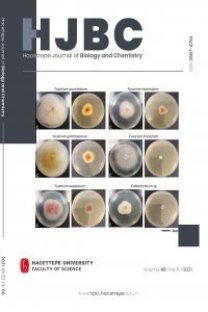Staphylococcus Aureus’a Karşı Lizozim Çapraz Bağlı Antibadi Destroyerler
Staphylococcus aureus, IgG, biyokonjugasyon
Lysozyme Cross-Linked Antibodious Destroyers Against Staphylococcus Aureus
Staphylococcus aureus, IgG, bioconjugation,
___
- 1. G.D. Wright, Bacterial resistance to antibiotics: enzymatic degradation and modification, Advanced Drug Delivery Reviews, 57 (2005) 1451-1470.
- 2. R. Satishkumar, A. Vertegel, Charge‐directed targeting of antimicrobial protein‐nanoparticle conjugates, Biotechnology and Bioengineering, 100 (2008) 403-412.
- 3. S.C. Yadav, A. Kumari, R. Yadav, Development of peptide and protein nanotherapeutics by nanoencapsulation and nanobioconjugation, Peptides, 32 (2011) 173-187.
- 4. E. Gustafssona, S. Karlssona, J. Oscarsson, P. Sogard, P. Nilsson, S. Arvidson, Mathematical modelling of the regulation of spa (protein A) transcription in Staphylococcus aureus, International Journal of Medical Microbiology 299, (2009) 65-74.
- 5. M. Askarian, A. Zeinalzadeh, A. Japoni, A. Alborzi, Z.A. Memish, Prevalence of nasal carriage of methicillin-resistant Staphylococcus aureus and its antibiotic susceptibility pattern in healthcare workers at Namazi Hospital, Shiraz, Iran International Journal of Infectious Diseases, 13 (2009) 241-247.
- 6. R. Saginur, K.N, Suh, Staphylococcus aureus bacteraemia of unknown primary source: Where do we stand? International Journal of Antimicrobial Agents, 32 (2008) 2-25.
- 7. N. Palmqvist, G.J. Silverman, E. Josefsson, A. Tarkowski, Bacterial cell wall-expressed protein A triggers supraclonal B-cell responses upon in vivo infection with Staphylococcus aureus, Microbes and Infection, 7 (2005) 1501-1511.
- 8. L. Pan, F. Yue, J. Miao, L. Zhang, J. Li, Molecular cloning and characterization of a novel c-type lysozyme gene in swimming crab Portunus trituberculatus, Fish & Shellfish Immunology, 29 (2010) 286-292.
- 9. M. Khalili, A. Liwo, H. A. Scheraga, Kinetic Studies of Folding of the B-domain of Staphylococcal Protein A with Molecular Dynamics and a United-residue (UNRES) Model of Polypeptide Chains, J Mol Biol., 355 (2006) 536-547.
- 10. T. J. Foster, Immune Evasion by Staphylococci, Nature Publishing Group 3, (2005) 948-958.
- 11. K. Greenhalgh, E. Turos, In vivo studies of polyacrylate nanoparticle emulsions for topical and systemic applications, Nanomedicine: Nanotechnology, Biology, and Medicine, 5 (2009) 46-54.
- 12. J.S. Kim, E. Kuk, K.N. Yu, J.H. Kim, S.J. Park, H.J. Lee, S.H. Kim, Y.K. Park, Y.H. Park, C.Y. Hwang, Y.K. Kim, Y. S.Lee, D.H. Jeong, M.H. Cho, Antimicrobial effects of silver nanoparticles, Nanomedicine: Nanotechnology, Biology, and Medicine, 3 (2007) 95-101.
- 13. A. Nanda, M. Saravanan, M. Phil, Biosynthesis of silver nanoparticles from Staphylococcus aureus and its antimicrobial activity against MRSA and MRSE, Nanomedicine: Nanotechnology, Biology, and Medicine, 5 (2009) 452-456.
- 14. R. Say, Photosensitive amino acid-monomer linkage and bioconjugation applications in life sciences and biotechnology. World Intellectual Property Organization Patent Scope. 2011,www. wipo.int/patentscope/search/en/WO2011070402 (Pub. No.:WO/2011/070402; Int. Appl. No.: PCT/ IB2009.055707).
- 15. M. Liu, S. Zhang, Z. Liu, H. Li, A. Xu, Gene, 367 (2006) 110-117.
- 16. I. Fedtke, F. Gotz, A. Peschel, Bacterial evasion of innate host defenses–the Staphylococcus aureus lesson, International Journal of Medical Microbiology, 294 (2004) 89-194.
- 17. A. Bera, R. Biswas, S. Herbert, E. Kulauzovic, C. Weidenmaier, A. Peschel, F. Gotz, Influence of wall teichoic acid on lysozyme resistance in Staphylococcus aureus, Journal of Bacteriology, 189 (2007) 280-283.
- 18. R. Say, R. Keçili, Ö. Biçen, F. Yılmaz, D. Hür, A. Denizli, A. Ersöz, A novel nanoprotein particle synthesis: Nanolipase, Process Biochemistry, 46 (2011) 1688- 1692.
- 19. M. Bradford, A rapid and sensitive method for the quantitation of microgram quantities of protein utilizing the principle of protein-dye binding, Analytical Biochemistry, 72 (1976) 248-254.
- ISSN: 2687-475X
- Yayın Aralığı: 4
- Başlangıç: 1972
- Yayıncı: Hacettepe Üniversitesi, Fen Fakültesi
Murat ŞİMŞEK, Zakir M.o. RZAYEV, Ulviya BUNYATOVA, Sevda KHALİLOVA, Mustafa TÜRK
Süleyman Yalçınkaya, Didem Çakmak
Gözde AYDOĞDU TIĞ, Ecem Özlem BOLAT, Bülent ZEYBEK, Şule PEKYARDIMCI
Fitoremediasyon (Yeşil Islah) Yöntemi ile Ortamdan Ağır Metal Uzaklaştırılması
Muhammet Güler, Zehra Başı, Vedat Türkoğlu, M. Rıza Kıvanç
Fitoremediasyon Yeşil Islah Yöntemi ile Ortamdan Ağır Metal Uzaklaştırılması
Okratoksin A Tayinine Yönelik Elektrokimyasal Aptasensör Geliştirilmesi
Elif VARGUN, Zekiye SİSLİ, Ferah YILMAZ, Hayrünisa Baş SERMENLİ
